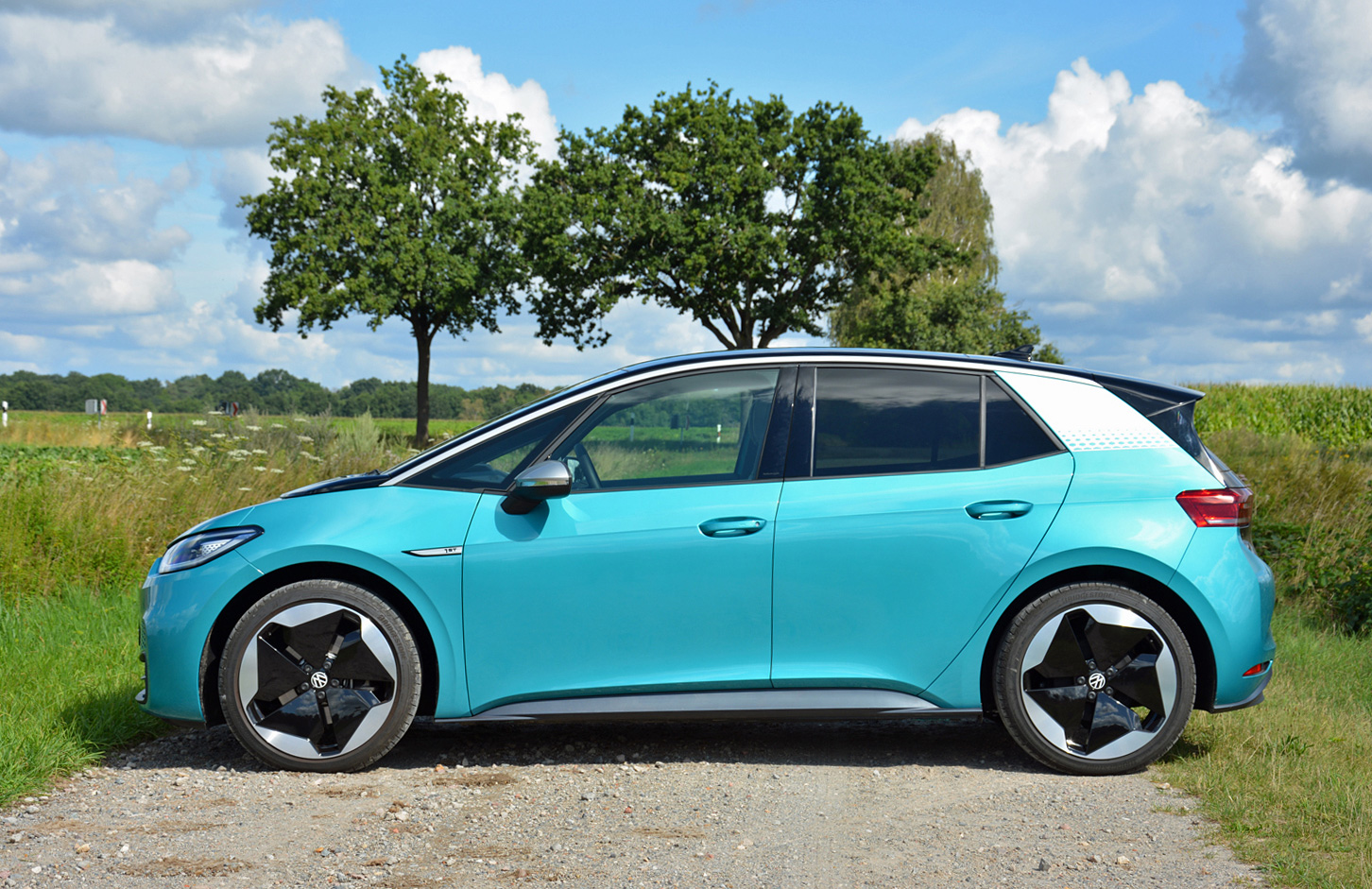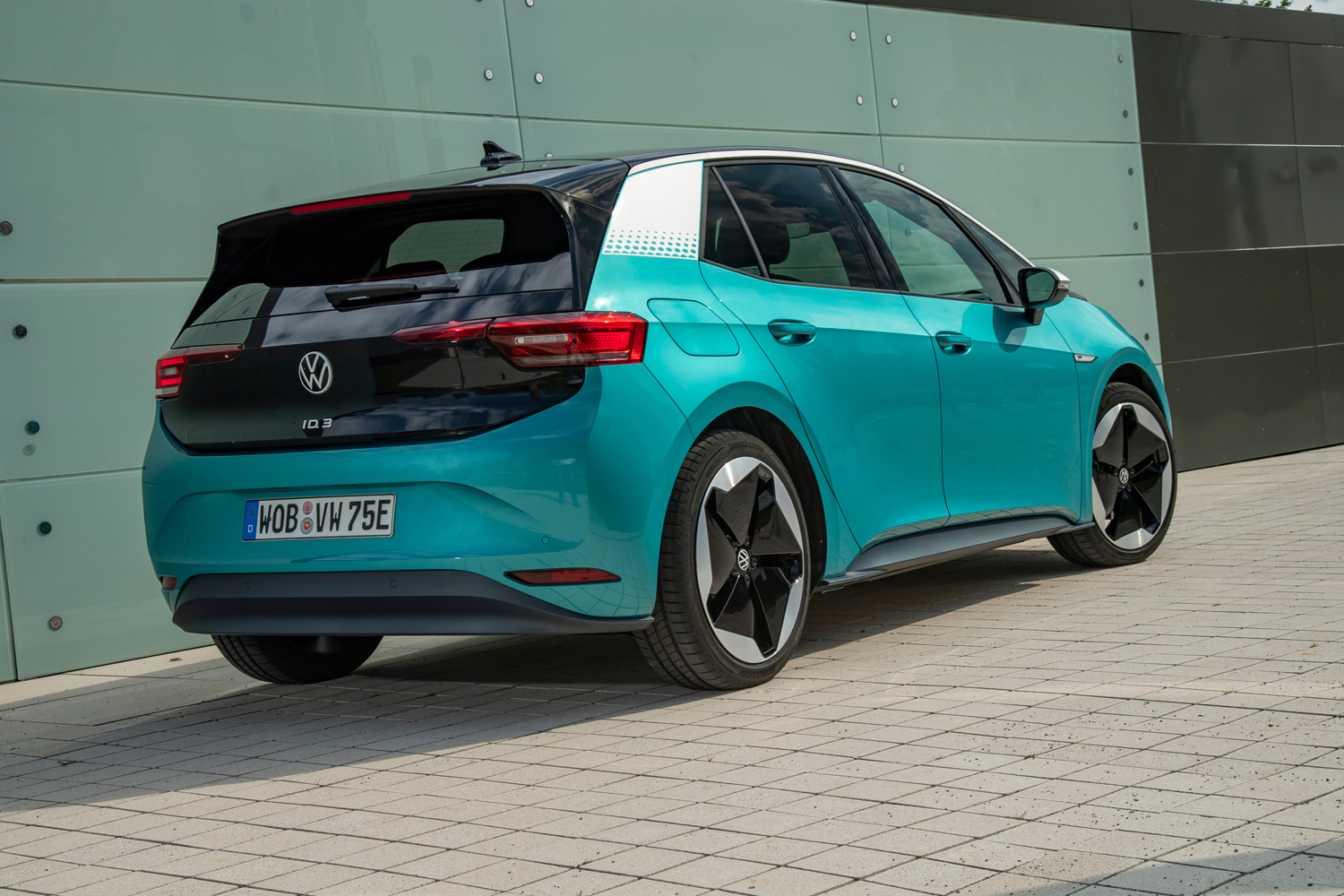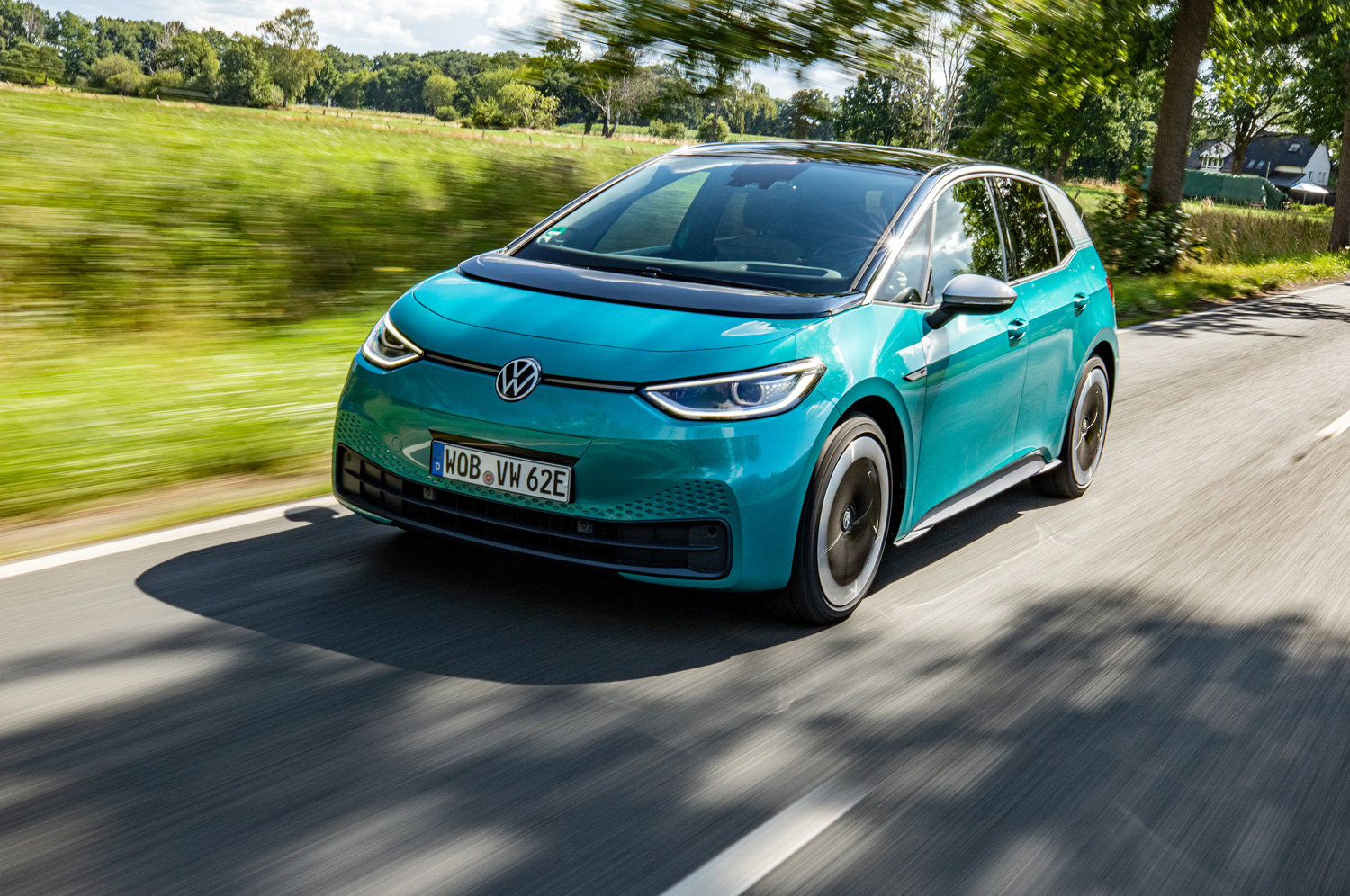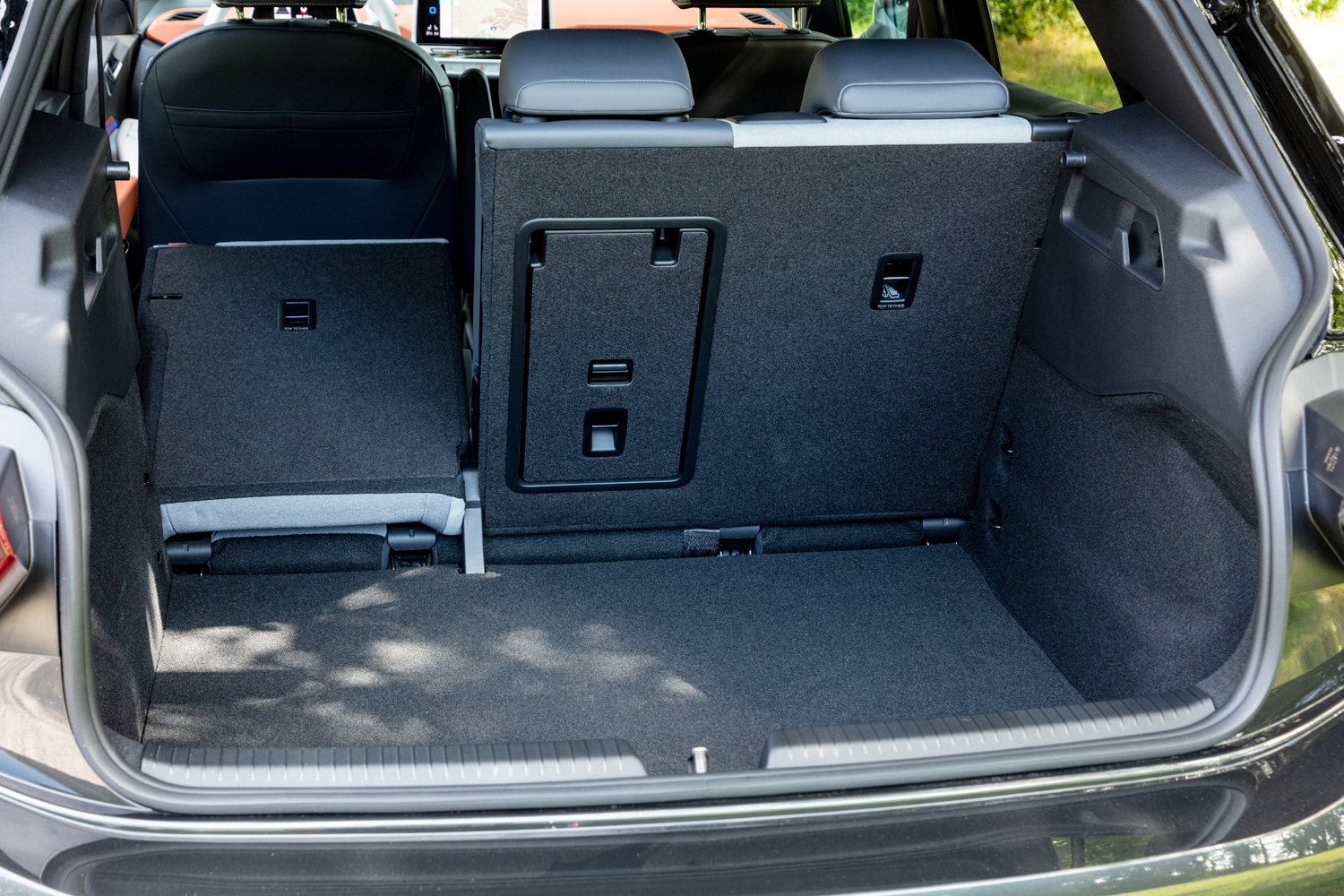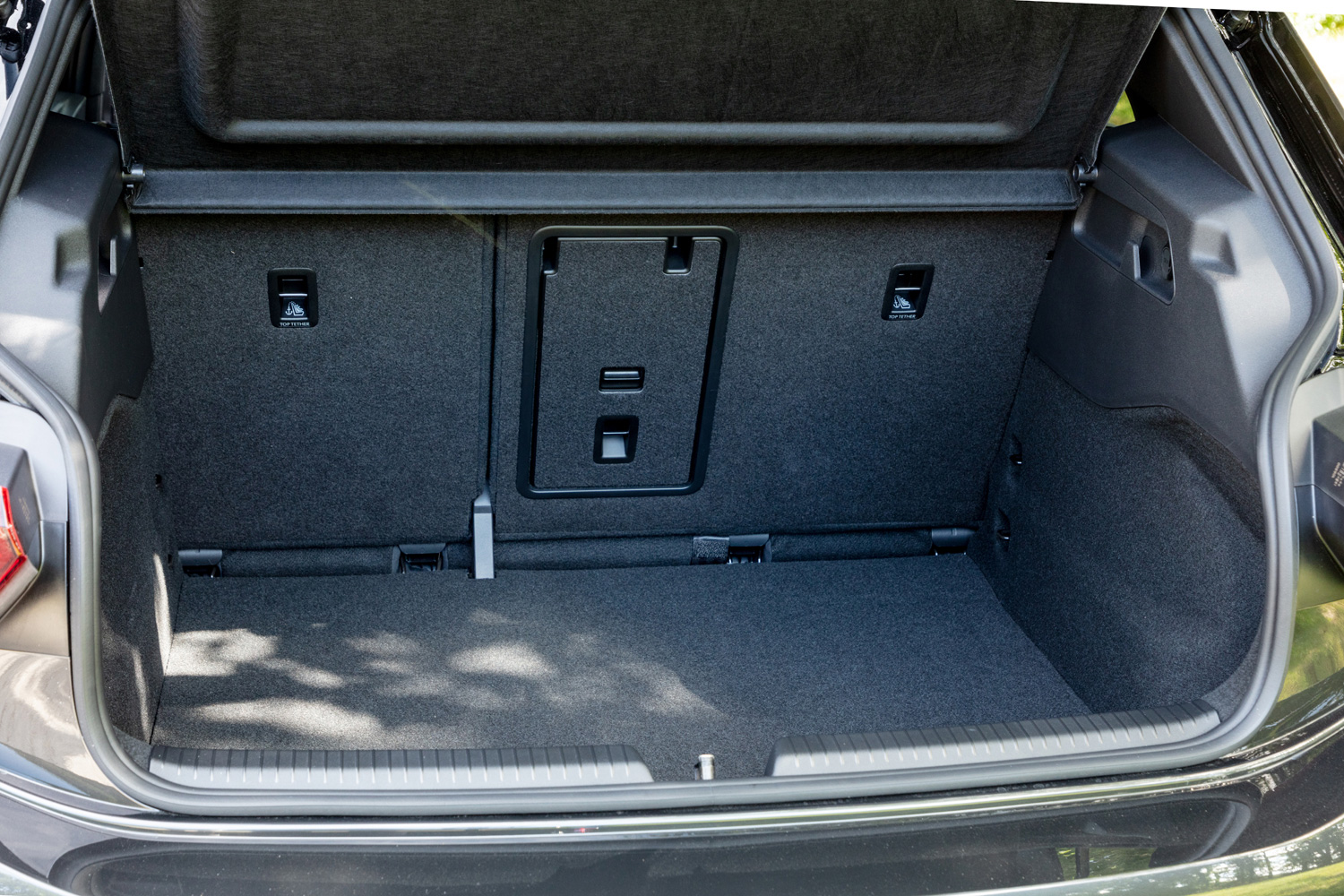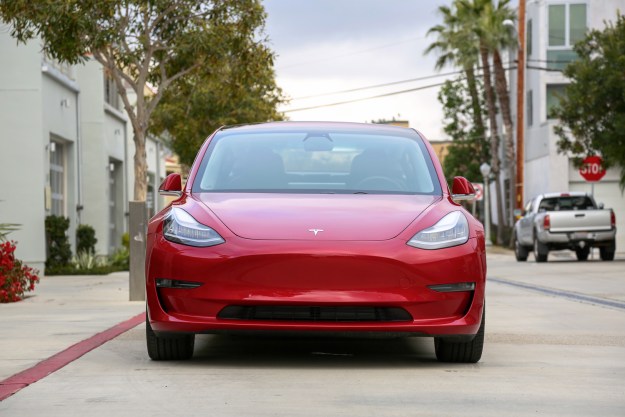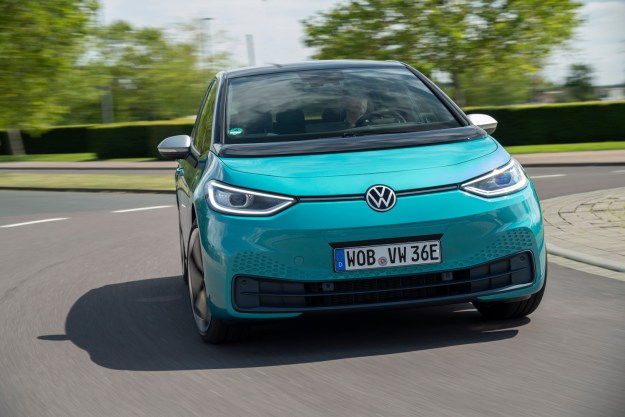
“Attractive and usable, the Volkswagen ID.3 is an EV you can live with daily”
- Smooth, linear powertrain
- Usable electric range
- Extra-spacious interior
- No volume knob
- Expensive
After stopping to take a few photos, I briefly broke the rear wheels loose while pulling off a dirt road, which was hardly unusual. What surprised me was that this happened behind the wheel of a Volkswagen. The company has largely steered clear of rear-wheel drive vehicles since it ended production of the emblematic, rear-engined Beetle. Although the ID.3 opens the next chapter in the Volkswagen story, it also picks up where its sought-after ancestor left off.
Before we dive in, let’s dispel a myth: No amount of poking and prodding will convince Volkswagen to sell the ID.3 in the United States. It’s plainly not happening. And yet, it’s worth a closer look because the technology it inaugurates will permeate over half a dozen upcoming electric cars, including a Tiguan-sized crossover named ID.4 that will eventually be built in the U.S., and the long-awaited modern-day Bus previewed by the ID.Buzz concept.
Starting from scratch
Volkswagen developed the ID.3 on a blank slate. It’s not an electric version of an existing car, like the e-Golf was, and it shares almost no parts with other recent additions to the company’s range, such as the eighth-generation Golf. It’s its own thing; it marks the beginning of a new adventure for Volkswagen. It’s built on a purpose-designed architecture named MEB that’s rear-wheel drive in its standard configuration — though making it all-wheel drive is as simple as adding a second electric motor over the front axle. Volkswagen told me MEB is flexible enough to underpin anything from a city-friendly hatchback to a family-sized SUV. Sedans, wagons, and vans are planned, too.

Although the ID.3 is recognizable as a member of the Volkswagen family, it shares very few styling cues with its siblings, and its proportions are anything but anodyne. It’s 100 percent electric, it wasn’t designed with any kind of internal combustion engine in mind (not even a range extender), so stylists were able to stretch its wheelbase to almost Passat-like proportions while reducing its overhangs. Its motor is compact enough to fit in a sport bag.
Stylists devoted a considerable amount of energy to reducing the ID.3’s visual mass with styling cues.
The ID.3 measures 167.8 inches from end to end, 71.2 inches wide, and 61.1 inches tall, meaning it’s an inch shorter, about an inch narrower, and four inches taller than the latest Golf. It’s a little bit higher than you’d expect because the lithium-ion battery pack that zaps the motor into motion is stuffed directly under the passenger compartment. Silke Bagschik, Volkswagen’s head of electric car marketing and sales, explained stylists devoted a considerable amount of energy to reducing the ID.3’s visual mass with styling cues like plastic cladding on the bottom of the doors, and a curved piece of trim that stretches from the base of the windshield to the tip of the rear hatch.
Do these mind tricks work? You tell me.
While the ID.3 is slightly taller than the average hatchback, it’s also a lot more spacious inside. The floor is slightly higher than you’d expect, again due to the battery under it, but it’s completely flat and there’s a surprising amount of legroom regardless of whether you’re sitting in the front or in the back. It offers 13.5 cubic feet of trunk space, room for four or five adults depending on how it’s configured, plus numerous storage bins scattered throughout the cabin. And, yes, the pedals are marked with play and pause, just like on the ID concept introduced at the 2016 edition of the Paris auto show, and on the head-turning ID.Buggy concept I drove in sunny California in 2019. The aforementioned production version of the retro-fabulous ID.Buzz concept tentatively due out in 2022 will get them, too.

Apple? Is that you?
From the driver’s seat, the ID.3 feels like a car that took all-you-can-eat turns at the technology counter, and saved a small sliver of heritage for dessert. It’s a fascinating paradox. Instead of looking at round gauges, the driver faces a 5.3-inch screen that displays everything you need to know while driving (like the speed, the available driving range, and navigation directions) and nothing superfluous. Although the electric motor can spin at up to 16,000 rpm, you won’t find a tachometer in your line of sight. I like this straightforward approach, but it’s not new. In a way, it reminds me of my 1972 Beetle, which has an equally simple instrument cluster that consists of a single gauge. It groups an analog speedometer, an odometer, a fuel gauge (that’s broken after nearly 50 years), and … that’s it.

There’s a free-standing, 10-inch touchscreen on the dashboard. It displays a new infotainment system designed to look and feel like a tablet. It’s easy to use, its graphics are sharp, it responds quickly to input, and its menus are logically laid out. Touch-sensitive sliders located right below the screen replace the climate control system’s bulky knobs, dials, and buttons. There’s another touch-sensitive slider used to adjust the stereo’s volume, plus additional touch-sensitive buttons on the steering wheel that control the various driving aids (like the adaptive cruise control). Do you notice a pattern? Nearly everything inside the ID.3 is touch-enabled, except for key systems such as the turn signals and the windshield wipers that really shouldn’t be replaced by buttons on a screen for safety’s sake.
Touch-sensitive sliders located right below the screen replace the climate control system’s bulky knobs, dials, and buttons.
Volkswagen retained conventional power window switches, but there are only two embedded into the driver-side door panel instead of four. Opening or closing the rear windows from the driver’s seat requires pressing a backlit button that’s — you guessed it — touch-sensitive to engage them, and using the same two switches that command the front windows. Tapping it again disengages the rear windows and sends power back to the front ones.
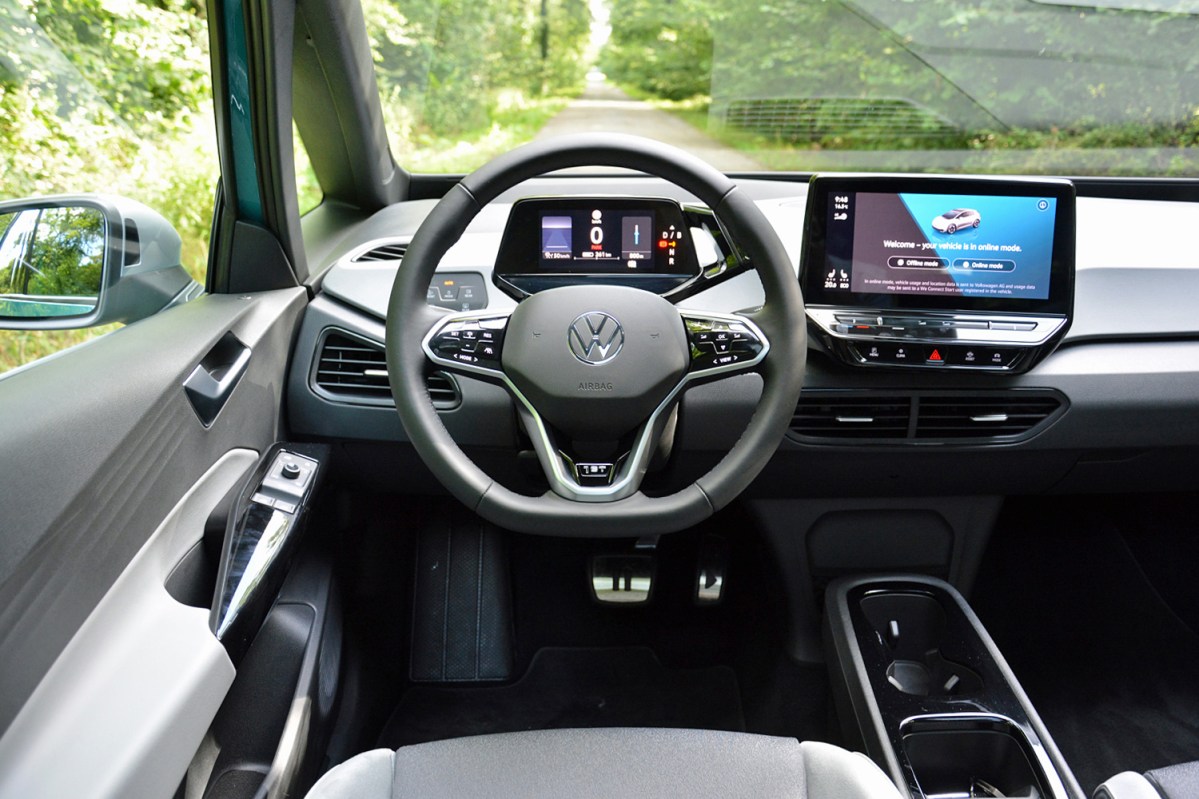
From the driver’s seat, before you even get moving, the ID.3 feels like a giant iPhone. I know this is an overused cliché, but I’ve never experienced a vehicle that embodies it so accurately. It’s been several years since we’ve heard anything about Apple’s on-again, off-again car project, so the ID.3’s blend of simple, uncluttered design and user-friendly technology makes it the closest thing to the long-rumored iCar that’s ever entered mass production.
Easy does it
One of the only buttons you’ll find in the cabin is located on the right side of the steering column. It’s used to wake up the electric motor. Volkswagen told me it didn’t need to add this feature, its engineers could have easily programmed the car to wake up on its own by detecting its key fob, but it chose to add it at the last minute because it realized some owners making the switch from gasoline to electricity will appreciate a dose of familiarity in an otherwise unfamiliar environment. Driving off is as simple as pushing the brake pedal — I mean, pushing the pause pedal — and twisting a small lever next to the instrument cluster to put the car in gear.
As of writing, buyers have three lithium-ion battery pack sizes to choose from: 48, 62, and 82 kilowatt-hours. These numbers correspond to 205, 260, and 340 miles of maximum driving range, though note those figures were obtained on the WLTP testing cycle used in Europe, which unabashedly leans on the optimistic side of the scale when it comes to electric vehicles. Regardless of which battery pack you’re sitting on, it channels the electricity it stores to a rear-mounted motor rated at 204 horsepower and 228 pound-feet of instant torque. Electric cars are heavier than comparable gasoline-powered models, and the roughly 3,790-pound ID.3 is no exception. And yet, its zero-to-62-mph time checks in at 9.2 or 7.3 seconds, depending on how it’s configured. It’s not quick, but it’s brisk.
Smooth and zippy, the ID.3 is a true urban native that’s happy to dart from light to light in crowded cities.
Smooth and zippy, the ID.3 is a true urban native that’s happy to dart from light to light in crowded cities. Its design forces onlookers to pause mid-meal, stare for a few seconds, and wonder if they should report a UFO sighting. The best part about driving this car in an urban center isn’t interrupting meals; it’s the dazzlingly tight turning radius, which makes maneuvering in or out of a parking spot a breeze. Volkswagen explained it was able to teach the ID.3 to turn on a dime because there’s no engine between the front wheels, so it’s reasonable to assume that the other rear-wheel drive members of the ID family will offer motorists the ability to make a three-point turn in one go.
It’s pleasant to drive on Germany’s sinuous back roads, where the relatively aggressive energy recuperation system — when engaged using the same lever that puts the car in gear — allows for one-pedal driving. Instead of braking when entering a town, for example, you can simply take your foot off the accelerator pedal and let the ID.3 slow itself down while the motor harvests kinetic energy and channels it back to the battery. Alternatively, the adaptive cruise control analyzes navigation data and automatically begins to slow the hatchback down when it detects the speed limit is about to change. The instrument cluster displays a message to tell the driver what’s going on; if you’re cruising at 100 kph, it flashes “70 ahead” before it begins slowing down so you’re not surprised by the car making decisions for you.

Don’t be fooled by the specifications sheet. The ID.3 is rear-engined and rear-wheel drive, but it doesn’t feel rear-biased like, say, a Porsche 911 or the current-generation Renault Twingo that’s popular on this side of the pond. The heaviest part of the car is the battery, and it takes up most of the space between the axles, so the ID.3 feels … bottom-biased. Its center of gravity is lower than a Golf’s, so it’s firmly planted on the road. If it’s all-out performance you’re after, you’ll need to patiently wait until Volkswagen releases a line of zestier electric cars. It’s too early to tell if the ID.3 will be part of the range, though it would lend itself well to a sportier chassis setup.
Instead, the ID.3 is best enjoyed when driven in a calm, relaxed manner. It delivers linear acceleration, partly because the motor spins the rear wheels through a fixed-ratio gearbox that never changes gears. The steering is well-weighted without much feedback, and the ride is rather firm but not punishing. And, the ID.3 is incredibly silent once the pedestrian warning chime turns off above 12 mph. The only noise in the cabin comes from the wind and from the tires, but neither is excessive or annoying — and both are inevitable regardless of what powers a car.
The ID.3 is incredibly silent once the pedestrian warning chime turns off above 12 mph.
Using my phone and an app called Sound Meter, I recorded about 68 decibels in the ID.3’s cabin while traveling at 75 mph on an empty German freeway. There were no other cars around; it was just the battery-powered Volkswagen and I. Of course, the windows were closed and the stereo was off. Granted, that’s hardly a scientific measurement, and I will never present myself as a car-interior-noisologist, so take this reading with a grain of salt. The app explained 68 decibels is on par with a normal conversation. For context, it noted a 20-decibel rating is as quiet as a mosquito, and 40 decibels corresponds to the noise level in a library. And, remember the 1972 Beetle I mentioned earlier? Its air-cooled flat-four engine belts out about 82 decibels when I start it after it’s been sitting for a few days.
The ID.3’s user interface remains intuitive, though I wish Volkswagen had included a volume knob instead of a slider — I like those better when they’re edible, preferably stuffed with beef and cheddar. It’s not the most precise way to crank the stereo up or down. And, the two-stage buttons on the multi-function steering wheel are extremely sensitive, though I imagine applying the right amount of pressure is a habit you likely get into after spending several days behind the wheel. As for the cool augmented-reality head-up display announced in 2019, Volkswagen told me it was delayed by the on-going coronavirus pandemic that forced it to put its global operations in neutral. The feature will be beamed to the ID.3s ordered with it via an over-the-air software update before the end of 2020.
My time behind the wheel of the ID.3 was too short to accurately measure its driving range, though it’s important to remember how far you manage to make a charge last depends on a diverse selection of factors including your driving style, what you’re carrying, and the road conditions. Volkswagen stressed the 77-kilowatt-hour battery pack is compatible with quick-charging, 125-kilowatt technology. The two smaller packs top out at 100 kilowatts.
Our take
With the ID.3, Volkswagen proves it’s serious about pushing electric vehicles into the mainstream. It’s a car that represents a holistic, ground-up, and engineering-led effort at making battery-powered technology attractive, usable, and relatively affordable for as many motorists as possible. Mainstream is the keyword here. Volkswagen pointed out it’s a volume-oriented manufacturer, so its decision not to sell the ID.3 in the United States, where hatchbacks are cooped up in a shrinking niche, makes perfect sense from a business and marketing standpoint. Put plainly, no one would buy it. That’s why the standard Golf won’t return, and why Honda is keeping the E away from our shores.
Electric technology still isn’t cheap, even when we’re talking about a mass-produced car, so the ID.3 is considerably more expensive than a comparable gasoline-powered hatchback. In Germany, its home market, it carries a base price of 35,574 euros (about $42,000) before the various available incentives are factored in. To put this figure into perspective, the Golf starts at 19,880 euros (about $23,500) and an entry-level Audi A4 costs 33,240 euros (about $39,000). But, if you’re willing to pay the price, if you’ve decided an electric car suits your lifestyle, and if you live in a market where the ID.3 will be available, it’s an excellent choice that can feasibly be the only car in your garage.
Americans need not apply, even if they ask nicely, but everything I liked about the ID.3 (including its smooth powertrain and its user-friendly technology) will arrive on our shores in a bigger, taller package named ID.4 that’s due out in 2021. It will be positioned in the same burgeoning segment as the Ford Mustang Mach-E, the Nissan Ariya, and the Tesla Model Y, among many others, but Volkswagen stressed it will also be pegged as an alternative to the Toyota RAV4 and the Honda CR-V. It’s going to get crowded; let the games begin.
Editors' Recommendations
- Volkswagen ID.4 vs Tesla Model Y
- 2022 Volkswagen ID. Buzz first drive review: The iconic hippie hauler goes electric
- 2021 Volkswagen ID.4 AWD first drive review: Gaining traction
- 2021 Volkswagen ID.4 electric car prototype drive: A crowd-pleaser
- 2021 Volkswagen ID.4 aims to (finally) bring electric cars to the masses

